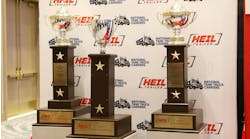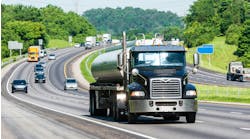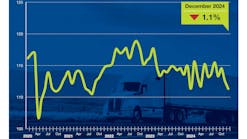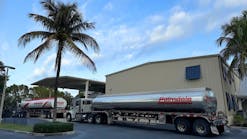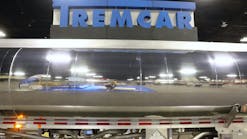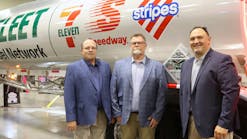After nearly five years and $1.5 billion in development, the new heavy-duty Detroit Diesel DD15 engine was unveiled at the Detroit Diesel factory in Redford, Michigan. The investment included a $275-million upgrade to the plant itself.
Displacing 14.8 liters in an inline, six-cylinder configuration, the DD15 is the first in a series of new heavy-duty engines that will be produced in three versions: 12.8 liters, 14.8 liters, and 15.6 liters. The 12.8-liter DD13 will enter production in 2009 (as a replacement for the MBE 4000 in North America), followed by the 15.6-liter DD16 in 2010.
The DD15 will be offered in output and torque variants of 455 to 560 horsepower and 1,550 to 1,850 lb/ft, including dual torque ratings for special applications. The inline six-cylinder engine has a dry weight of 2,970 pounds.
The market launch of the DD15 in the Freightliner Cascadia will take place in the second quarter of 2008, followed by the Freightliner Century S/T and Columbia models and the Sterling setback L-Line and A-Line. By third quarter 2008, the DD15 will be available in Western Star 4900 and Freightliner Coronado tractors. The DD15 will fully replace the Detroit Diesel Series 60 engine in North America by 2010.
Designed for on-highway applications, the DD15 is part of Daimler AG's Heavy-Duty Engine Platform. The new engine family will be manufactured in Germany and Japan, as well as the United States. Ultimately, it will replace the current engines being used in Daimler's heavy-duty truck brands, including Mercedes-Benz and Mitsubishi Fuso.
The Heavy-Duty Engine Platform features 90% globally shared parts. “As part of our Global Excellence Program, we are making greater use of common parts and modules across all of our brands,” said Andreas Renschler, Daimler board of management, Trucks Division.
The DD15 was jointly developed and tested by Daimler engineering teams in Germany, Japan, and the United States. During this process, the engine was subjected to intense trials under some of the most extreme operating conditions, according to Daimler officials. More than two dozen units were endurance-tested, running for well over 100,000 operating hours (the equivalent of several million miles on the road).
“This intercontinental process involved unprecedented cooperation among Daimler engineers around the world,” said Chris Patterson, president and chief executive officer of Freightliner LLC. “This marks an important step toward the realization of our global strategy.”
Twenty tractor-trailer combinations currently are undergoing road trials in the United States, Germany, and South Africa. These vehicles have covered approximately 3.5 million miles to date. The road testing is being done in all climatic conditions, from the Arctic winter to summer in the Desert Southwest.
The DD15 is tailored for North America's 2007 Environmental Protection Agency (EPA) emissions regulations, and its advanced design prepares it for the upcoming EPA 2010 requirements. The engine also was designed to comply with future environmental requirements in other markets. The engine is designed to work with downstream emission control technology, such as selective catalytic reduction.
“Instead of revamping our current engines to comply with the coming EPA standards, we designed a brand new heavy-duty platform that takes all of the global emissions requirements into account,” said Jim Gray, Heavy-Duty Engine Platform program director. The clean-sheet design enabled us to offer cleaner emissions in an engine that also boasts unsurpassed power and performance.”
The new engine offers best-in-class torque response, according to Gray. In fact, the DD15 exhibits up to 75% better torque response than the Series 60 engine. Features contributing to enhanced performance include the Amplified Common Rail System (ACRS), low-inertia dual overhead hollowed camshafts, and simplified turbocharger.
With four valves per cylinder, two overhead camshafts, a more efficient injection system, and fully electronic engine management, the engine offers excellent fuel economy, powerful performance, and smooth running characteristics, according to Gray. Other features include a cast-iron crankcase, a newly developed Jacobs engine brake, a turbocharger with intercooler, and turbo compounding technology that can reduce fuel consumption by up to five percent.
